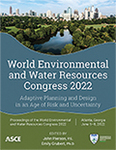The Brahmaputra River Flooding, Erosion, and Modeling for Sustainable Solutions
Publication: World Environmental and Water Resources Congress 2022
ABSTRACT
The Brahmaputra River, a large river system in Asia flowing 2,880 km from the Upper Himalayas to the Bay of Bengal through China, India, and Bangladesh, has been causing serious flooding and bank erosion damages in its nearly 800 km reach in the Indian state of Assam after its steep fall (~3 km) through approximately 250 km long narrow gorge crossing the China-India border. Unlike flooding, damages caused by erosion of the banks, including taking away residential properties, schools, cultural establishments, agricultural and industrial lands, and forests (state and national) serving homes for animals with endangered species, and even the flood control levees protecting the above, are permanent. Therefore, adequate erosion-control measures must be placed at active bank erosion sites to protect the above. There are many scientific challenges as the river is uniquely large and unstable. It has four constrictions playing major roles. A mathematical model of the river is needed to carefully study the river, account for effects of the constrictions and other features, and use it to design and align an adequate and stable channel of the river with sufficient capacity to convey the incoming flows of water and sediment. Next the stable and optimally aligned channel must be built and maintained using bank stabilization technologies and minimal dredging. In this paper and presentation, brief descriptions of the Brahmaputra River, its flooding and bank erosion problems, some of the challenges in solving those, and an approach as eluded above with the help of a mathematical model to overcome the challenges are presented and discussed.
Get full access to this article
View all available purchase options and get full access to this chapter.
REFERENCES
ASCE Task Committee on Hydraulics, Bank Mechanics, and Modeling of River Width Adjustment. 1998. RIVER width adjustment. II: Modeling. Journal of Hydraulic Engineering, ASCE, 124(9): 903–917.
Borah, D. K., C. V. Alonso, and S. N. Prasad. 1982. Routing graded sediments in streams: formulations. Journal of the Hydraulics Division, ASCE, 108(12): 1486–1503.
Borah, D. K., and P. K. Bordoloi. 1989. Stream bank erosion and bed evolution model. Proceedings of the International Symposium on Sediment Transport Modeling, August 14-18, 1989, New Orleans, LA, ASCE: 612–617.
Borah, D. K., and M. S. Dashputre. 1994. Field evaluation of the sediment transport model STREAM with a bank erosion component. Proceedings of the 1994 National Conference on Hydraulic Engineering, August 1-5, 1994, Buffalo NY, ASCE: 979–983.
Camacho, R. A., Z. Zhang, and X. Chao. (2019). “Receiving Water Quality Models for TMDL Development and Implementation.” Journal of Hydrologic Engineering 24(2): 04018063, ISSN: 1084-0699 (print), 1943-5584 (online).
Coleman, J. M. 1969. Brahmaputra River: Channel processes and sedimentation. Sedimentary Geology, Vol. 3, 129–239.
Garcia, M. H., ed. 2008. Sedimentation Engineering: Theory, Measurements, Modeling, and Practice. ASCE Manual 110, ASCE Environmental and Water Resources Institute, Reston,VA.
Goswami, D. 1985. Brahmaputra River Assam, India, Physiography, Basin denudation and channel aggradation. Water Resources Research 21(7), 959–978.
Handique, G. K. 2010. The Brahmaputra River System – Its Problems, Challenges & Potential. North East India International Meet 2010, January 11, 2010, Pragjyoti ITA Center, Machkhowa, Guwahati, India.
Phukan, A., R. Goswami, D. Borah, A. Nath, and C. Mahanta. 2010. River bank erosion and restoration in the Brahmaputra River in India. Proceedings of the ASCE-EWRI 3rd International Perspective on Current & Future State of Water Resource and Environment, January 5-7, 2010, Chennai, India. ASCE-EWRI, Reston,VA.
Sarkar, M. H., and C. R. Thorne. 2006. Morphological response of the Brahmaputra-Padma-Lower Meghna River system to the Assam Earthquake of 1950., International Association of Sedimentologists.
Sarma, J. N. 2005. Fluvial process and morphology of the Brahmaputra River in Assam, India. Geomorphology, Elsevier, Vol. 70, issue 3-4, 226–256.
US Army Corps of Engineers – Hydrologic Engineering Center. 2021. HEC-RAS. https://www.hec.usace.army.mil/software/hec-ras/ (accessed: October 21, 2021).
Information & Authors
Information
Published In
History
Published online: Jun 2, 2022
Authors
Metrics & Citations
Metrics
Citations
Download citation
If you have the appropriate software installed, you can download article citation data to the citation manager of your choice. Simply select your manager software from the list below and click Download.
